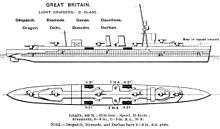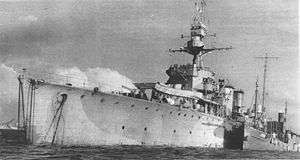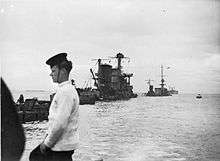Danae-class cruiser
 HMS Delhi; note 5"/38 caliber guns fitted after refit | |
| Class overview | |
|---|---|
| Name: | Danae class |
| Operators: | |
| Preceded by: | C class |
| Succeeded by: | Emerald class |
| In commission: | 1918 - 1946 |
| Planned: | 12 |
| Completed: | 8 |
| Cancelled: | 4 |
| Lost: | 3 |
| General characteristics | |
| Type: | Light cruiser |
| Displacement: |
|
| Length: | |
| Beam: | 46.5 ft (14.2 m) (47 ft (14 m) in Despatch and Diomede) |
| Draught: | 14.5 ft (4.4 m) (16.5 ft (5.0 m) full) |
| Propulsion: |
|
| Speed: | 29 knots (54 km/h; 33 mph) (27 knots full) |
| Range: | 2,300 nmi (4,260 km) at 27 knots (50.0 km/h) |
| Complement: | 450 / 469 war |
| Armament: |
|
| Armour: |
|
The Danae or D class was a class of light cruiser built for the Royal Navy at the end of World War I which also saw service in World War II.
Design

The Danaes were based on the design of the preceding C class series, but were lengthened by 20 feet (6 m) to allow a sixth 6-inch (152 mm) gun to be worked in between the bridge and the forefunnel. This gave an 'A', 'B', 'P', 'Q', 'X', 'Y' arrangement. Additionally, the twin torpedo tubes in the C class were replaced by triples, giving the Danaes a total of twelve tubes, the heaviest torpedo armament for a cruiser at the time. Machinery and general layout was otherwise the same as the Ceres group of C-class cruisers. However, Danae, Dauntless and Dragon were ordered before the Capetown group, and therefore did not incorporate the improved bow design of the latter; the C class were very wet forwards, and in the Capetowns sheer was increased forwards into a knuckled "trawler bow". Such was the success of the knuckled bow that it was incorporated into all subsequent British cruisers (except Birmingham of 1935 which was completed without). Despatch and Diomede had their beam increased by ½ foot to increase stability and Dragon and Dauntless were completed with a hangar for a floatplane built into the bridge, the compass platform being on top. Delhi, Dunedin, Durban, Despatch and Diomede were provided with flying-off platforms for a wheeled aircraft aft. Despatch and Diomede were completed with 4 inch anti-aircraft (A/A) guns vis 12 pounder (3 inch) guns in their sisters and Diomede had 'A' gun shipped in a weatherproof housing CP Mark XVI, an encouraging development for gun crews hitherto exposed to the worst of the elements on the fo'c'sle.
Modifications

The lessons of the Battle of Jutland were applied and protection was improved in detail. Additional torpedo tubes were installed and depth charge throwers were also included. The Mk XII 6-inch (152 mm) gun was retained but, in Diomede, a new prototype gun house (allowing greater elevation) was used and found to be most satisfactory.
Inter-war, all ships had their anti-aircraft armament standardised as three QF 4 inch Mark V guns on mountings HA Mark III, with a QF 2 pdr Mk.II gun in each bridge wing. All aircraft equipment were removed and Dragon and Dauntless had their bridges rebuilt along the lines of the rest of the class.
Early modifications in World War II included the addition of Radar Type 286 air warning at the foremast head and, later, Type 273 centimetric target indication set on the searchlight platform amidships. Between 6 and 8 20 mm Oerlikon guns were generally added, replacing the old 2 pounder guns in the bridge wings, on either side of 'P' and 'Q' guns and on the quarterdeck. In 1942, Dauntless (and in 1943, Danae) had the aft 4 inch A/A gun replaced by a quadruple mounting Mark VII for the 2 pounder Mark VIII gun and in 1943, Danae and Dragon had 'P' gun and the forward pair of 4-inch (102 mm) guns replaced by two such mountings and their Radar Type 282 equipped directors. Dragon and Danae were taken in hand again in 1943 and had the aft 4 inch / 2 pounder mountings replaced by a twin Mounting Mark XIX for the QF 4 inch Mark XVI gun. Danae also received twin in lieu of single Oerlikon mounts and later received a pair of single Bofors 40 mm guns. Diomede landed her torpedo tubes in 1943 and received one twin mount ""Hazemeyer" Mark IV and two single mounts Mark III for Bofors guns.

Between 1941 and 1942, Delhi was rebuilt in the United States as an anti-aircraft vessel. All armaments were removed, and five 5 inch L/38 Mark 12 guns in Mark 30 single mountings were added, controlled by a pair of Mark 37 Fire Control Systems. The guns were in all but the former 'P' position. She carried a new bridge and stepped light tripod masts fore and aft, carrying Radar Type 291 air warning. Sets Type 273 target indication was added amidships and Type 285 on the Mark 37 FCS for target ranging and bearings. The light armament consisted of two quadruple 2 pounder mounts Mark VII and their directors with Radar Type 282, a pair of twin Oerlikon mounts Mark V in the bridge wings and six single Mark III Oerlikon pedestal mounts.
Dragon and Durban were expended as breakwaters in support of the Normandy landings in June 1944, Dragon being replaced in Polish service by the Danae (as ORP Conrad) and Despatch was disarmed as a depot ship.
Ships
Three ships were ordered in September 1916 under the War Emergency Programme:
- Danae —
- built by Sir W. G. Armstrong Whitworth and Company, High Walker,
- laid down 11 December 1916, launched 26 January 1918, completed 18 July 1918,
- Transferred to the Polish Navy 4 October 1944 – 28 September 1946 as ORP Conrad, sold for breaking up 22 January 1948.
- built by Palmers Shipbuilding and Iron Company, Jarrow,
- laid down 3 January 1917, launched 10 April 1918, completed 2 December 1918,
- sold for breaking up 13 February 1946.
- Dragon — built by Scotts Shipbuilding and Engineering Company, Greenock,
- laid down 24 January 1917, launched 29 December 1917, completed 16 August 1918,
- Transferred to Polish Navy 15 January 1943, damaged by German Neger manned torpedo off Caen 8 July 1944, written off and expended as breakwater off Normandy beaches 20 July 1944.
Three more ships were ordered in July 1917 under the War Emergency Programme:
- Delhi —
- built by Armstrong Whitworth,
- laid down 29 October 1917, launched 23 August 1918, completed 7 June 1919,
- sold for breaking up 22 January 1948.
- Dunedin —
- built by Armstrong Whitworth,
- laid down 5 November 1917, launched 19 November 1918, completed by Devonport Royal Dockyard October 1919.
- Transferred to Royal New Zealand Navy 1925; torpedoed and sunk by the German submarine U-124 off Saint Paul's Rock in the South Atlantic 24 November 1941.
- Durban —
- built by Scotts,
- laid down 22 June 1918, launched 29 May 1919, completed by Devonport Royal Dockyard 1 September 1921,
- expended as breakwater off Normandy beaches 9 June 1944.
Finally, six more ships were ordered in March 1918 under the War Emergency Programme:
- Despatch —
- built by Fairfield Shipbuilding and Engineering Company, Govan,
- laid down 8 July 1918, launched 24 September 1919, completed Chatham Royal Dockyard 2 June 1922,
- sold for breaking up 5 April 1946.
- Diomede —
- built by Vickers Limited, Barrow-in-Furness,
- laid down 3 June 1918, launched 29 April 1919, completed Portsmouth Royal Dockyard 24 February 1922.
- Transferred to Royal New Zealand Navy 1925; sold for breaking up 5 April 1946.
- Daedalus — ordered from Armstrong Whitworth, cancelled 26 November 1918.
- Daring — ordered from William Beardmore and Company, Dalmuir, cancelled 26 November 1918.
- Desperate — ordered from R. & W. Hawthorn Leslie and Company, Hebburn on Tyne, cancelled 26 November 1918.
- Dryad — ordered from Vickers, cancelled 26 November 1918.
Notes
References
- Colledge, J. J.; Warlow, Ben (2006) [1969]. Ships of the Royal Navy: The Complete Record of all Fighting Ships of the Royal Navy (Rev. ed.). London: Chatham Publishing. ISBN 978-1-86176-281-8. OCLC 67375475.
- Jane's Fighting Ships of World War One (1919), Jane's Publishing Company
- Helgason, Guðmundur. "Danae class". German U-boats of WWII - uboat.net.
- Ships of the Danae class
- British and Empire Warships of the Second World War, H T Lenton, Greenhill Books, ISBN 1-85367-277-7
- Conway's All the World's Fighting Ships, 1922-1946, Ed. Robert Gardiner, Naval Institute Press, ISBN 0-87021-913-8
- Weyer, KKpt. a. D. B. (Hg.): Taschenbuch der Kriegsflotten. XXIV. Jg. 1928 (1927/29). J. F. Lehmanns Verlag, München 1928 [ND 1970], ISBN 3-469-00285-1
- Bredt, Lt. z. S. a. D. Alexander (Hg.): Weyers Taschenbuch der Kriegsflotten. XXX.Jg. 1936. J. F. Lehmanns Verlag, München 1936 [ND 1972], ISBN 3-469-00391-2
- Bredt, KLt. d. R. Alexander (Hg.): Weyers Taschenbuch der Kriegsflotten. XXXIV. Jg. 1940. J.F. Lehmanns Verlag, München/Berlin 1940 [ND Bernard & Graefe Verlag, München 1980]. ISBN 3-7637-5208-0
- Bredt, KKpt. d. R. Alexander (Hg.): Weyers Taschenbuch der kriegsflotten. XXXVI. Jg. 1943/44. J. F. Lehmanns Verlag, München/Berli 1944 [ND Bernard & Graefe Verlag, 2. Aufl. München 1982]. ISBN 3-7637-5238-2
| Wikimedia Commons has media related to Danae class cruiser. |